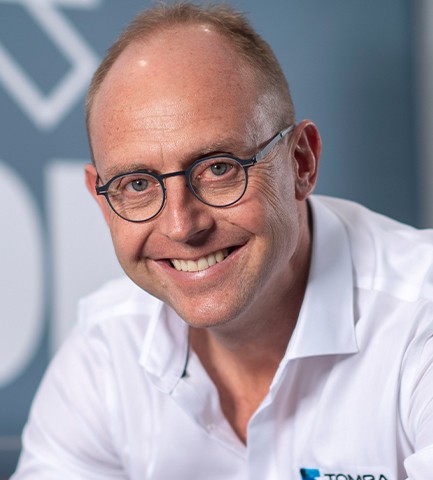
"We are focused on reducing the environmental impact of mining operations through sensor-based sorting."
Albert Du Preez
SVP, HEAD OF TOMRA MINING
How significant is the mining industry to TOMRA's business compared to other industries you work with?
TOMRA is Norwegian in origin, with a global presence. In Africa, it is present in markets across the region, including Namibia, Botswana, Lesotho and Sierra Leone. It has been operating in South Africa for approximately 12 years with its mining, recycling, and food business units.
Mining is one of the smaller business units within TOMRA, and its head office is in Hamburg-Wedel, Germany. We are focused on reducing the environmental impact of mining operations through sensor-based sorting. This is a disruptive new technology in most commodities in our industry, while it is well-established in the value chain of the recycling and food sectors. Today, sensor-based sorting is a standard process in industrial minerals and diamond mining, but as yet it is not widespread in other commodities, which we are looking to grow.
How does sensor-based sorting increase the value of the deposit and minimize waste?
Sensor-based sorting can use different types of sensors – X-Ray transmission (XRT), Near-Infrared (NIR), standard camera/visual light, laser, and electromagnetic – depending on the mineral and what is being detected. Sorting allows for waste removal, so that it does not have to be crushed, ground and processed, saving energy and costs. It also increases recoveries, as the feed grade is of a higher quality. We typically use very little or no water in the sorting process, reducing the downstream environmental impact.
In the mining environment, every deposit and mineral is unique, so we tailor our sensors to the commodity characteristics. Our biggest market in Southern Africa is diamonds, where sensor-based sorting is already an established technology in recovering diamonds. We revolutionized the diamond mining industry, and the five biggest diamonds found in the last 100 years were all beneficiated by TOMRA equipment. The industrial minerals market is our second largest, as it relies on sensor-based sorting for accurate detection and quality beneficiation. Sensor-based sorting has the capacity and robustness to be successful in the mining industry, and using it for high throughputs and volumes can benefit by minimizing energy consumption, environmental impact, and costs associated with processing minerals.
Can you elaborate on the capabilities of the TOMRA Insight platform?
TOMRA realized the strategic importance of data in sorting. Data is fundamental, and the more data is available, the better you can optimize processes and make good decisions. We have thus invested in a cloud-based data platform that allows for real-time, online access to all the data that the sorters gather during the entire process, known as TOMRA Insight. The information is collected and visualized for the client in such a way so that it is actionable and can optimize upstream or downstream processes. The client can follow up on the status and throughput of machines remotely. The platform also improves personnel efficiency, enables operators to act quickly, reduces the need to constantly monitor operations manually, guides efforts and interventions towards relevant actions, and improves operational performance due to less downtime.
What is hindering the development of the digital mining revolution in South Africa?
I believe that globally, the mining mind-set is the biggest constraint to the adoption of the digital revolution. Mining is a very conservative industry where people tend to follow the same processes, failing to see the opportunities that true innovation can bring. There is room for entrepreneurial thinking within the mining industry to make a change and catch up with other industries in terms of innovation.
What is TOMRA's strategy to gain market share and consolidate growth within the region?
Two years ago, we identified that the final recovery area within the diamond market is significant but that the technology available was not optimal. We thus developed a new platform, the COM XRT 300/FR, which focuses on final diamond recovery processes. We launched the product in 2021, and it has been well received in the market. With this product we can add tremendous value for our customers compared to competitors. We are looking forward to making a real change in the diamond industry moving forward.
We will continue to improve our sensor technologies, allowing for more accuracy and higher throughputs. We believe phosphates and potash is a growing market, and we look forward to increasing our market share in this sector. We aim to focus our resources in areas where our sensor-based sorting technologies can truly add value to our customers' operations, contributing to the global effort of building a sustainable future.











